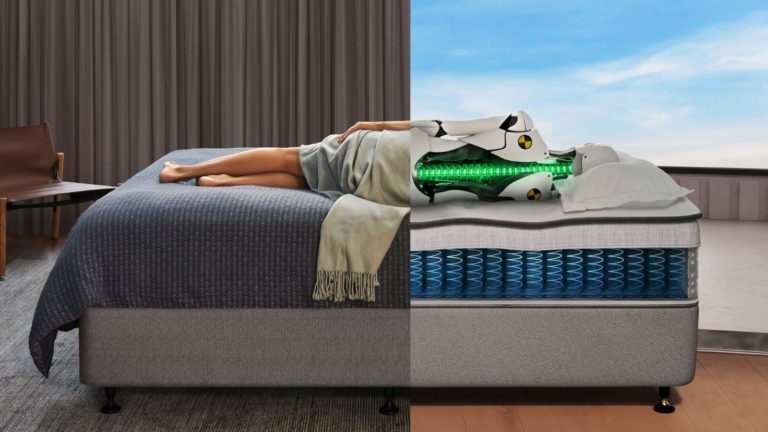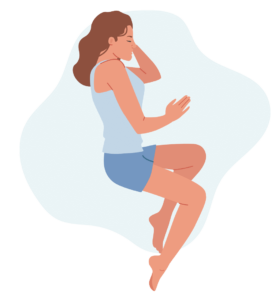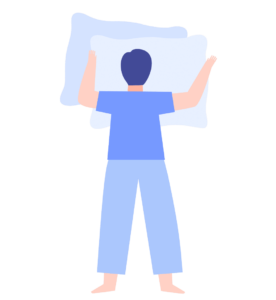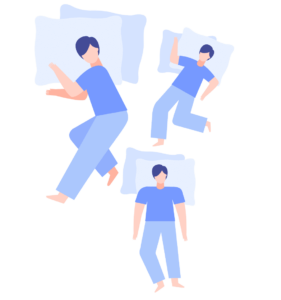The best sleeping position for you is one that maintains your posture and prevents spinal misalignment. Your muscles should be relaxed and able to recover. The best position for sleeping also depends on your individual comfort preferences and any relevant health concerns.
What is the best sleeping position?
There are four main types of sleep positions, including on the back, side, and front (or on the stomach). There are also combination sleepers who tend to move between different positions in their sleep. Sleeping positions are a highly personal choice. However, some positions tend to be favoured over others. Sleeping on your stomach is generally not ideal as it strains your spine and may result in an unnatural arch of the spine. Thus, sleeping on either your back or side is generally seen as a better sleeping position.

Best Sleeping Position for Side Sleepers
According to our sleep statistics, the majority of Australians are side sleepers — approximately 64%. With this in mind, it is no surprise that sleeping on your side is one of the healthier sleep positions.
Best Sleeping Position for Pregnancy
Resting on your side can help alleviate snoring and respiratory concerns, heartburn, and gut health issues, and it is preferred during pregnancy. The left-side position improves circulation, reduces pressure on the liver, and enhances blood flow to the fetus.
Best Sleeping Position for digestive Issues
Your body position affects the efficiency of your digestive system, and lying on your back can slow gas clearance. Those who suffer from heartburn, constipation, bloating, or other gastrointestinal issues may find relief by sleeping on their side.
Best Sleeping Position for Sleep Apnea
Side sleeping helps keep the airways open,gravity does not push the tongue and soft tissues backward, preventing obstruction. reducing snoring and symptoms of obstructive sleep apnea.

Side sleeping is particularly beneficial for:
- People with Acid reflux and heartburn
- Pregnant ladies (sleeping on the left side)
- People with sleep apnea or snoring issues
- Individuals with bloating or digestive issue:
We have some helpful guides that you may find useful:
Best mattress for side sleepers
Best pillow for side sleepers
Best Sleeping Position for Back Sleepers

Sleeping on your back can be particularly beneficial for those with joint pain, such as in the knees and hips. A popular choice, this position requires sufficient support from your mattress in order to maintain the alignment of your spine and prevent you from sinking too far down. Additionally, sleeping on your back benefits your skin. Since your face is not rubbing against a pillow, it reduces friction on your skin, potentially reducing skin irritation and wrinkles.
Best Sleeping Position for Neck Pain
Back sleeping is beneficial for neck pain because it helps maintain a neutral spine alignment, reducing strain on the neck and upper back. This position evenly distributes body weight, minimizing pressure points and preventing unnatural bending of the cervical spine. Using a supportive pillow that keeps the head aligned with the spine can further enhance comfort and reduce stiffness. Additionally, sleeping on the back allows the muscles to relax fully, promoting better posture and reducing tension that may contribute to neck discomfort.
Back sleeping is particularly beneficial for:
- People with scoliosis and back pain
- Migraine and Headache Sufferers
- People with acne-prone skin or those attempting to wrinkle prevention
Best Sleeping Position for Front Sleepers
If you’re in the habit of sleeping on your stomach, ensure your mattress and pillow are working to alleviate any spinal misalignment. Your hips are more likely to sink downwards as one of the heaviest points of your body, requiring optimal support to hold you upright. You are also more likely to experience neck pain, unless you have an appropriate pillow for lying on your front.
This position is not ideal for expectant mothers, but in some cases it may be of benefit to those with difficulty breathing at night.

Best Sleeping Position for Combination Sleepers

Combination sleepers are those who change their sleep positions throughout the night, usually resting on their front, side and back indiscriminately as they rest.
While many people naturally sleep this way, it is important to ensure that you are not needlessly tossing and turning throughout the night. Improper support can cause discomfort and place strain on your pressure points, prompting you to move and roll over while you sleep.
If your best sleep position is a combination, you may want to ensure that you have a pillow best suited to your comfort. This could be a pillow with a supportive depression in the middle and raised edges at the side.
Other Sleeping Positions
- Fetal Position: A curled-up version of side sleeping, named after the way babies rest in the womb.
- Freefall: A stomach-sleeping position where you tuck your hands under or around the pillow with your head turned to the side.
- Yearner: A side-sleeping posture with both arms and legs stretched out as if reaching for something—similar to how dogs often sleep.
- Soldier: A back-sleeping position where your arms remain straight by your sides, resembling a soldier standing at attention (but horizontally).
- Starfish: A back-sleeping posture where your arms and legs are spread out in all directions.
- Log: A side-sleeping position where the body remains straight with no bending at the waist, knees, or elbows.
- Cliffhanger: A couple’s sleeping position where both partners sleep on opposite sides of the bed, near the edges, with their backs facing each other.
Additional sleep tips
Is it good to sleep without a pillow?
Regardless of your sleep position, it is important to support your body, including your spine. Without a pillow, your neck is likely to bend at an awkward angle, causing strain, stiffness and discomfort.
Is it good to sleep with socks on?
Whether or not you sleep with socks on is largely dependent on personal comfort. Some benefit from the added warmth, while others may need to be careful, especially if they suffer from circulatory health issues.
Is it better to sleep in a cold room?
Research shows that it is easiest to fall asleep with a temperature of around 18°C. High temperatures can disturb your sleep; however, this is also dependent on your personal preference and any pre-existing health conditions.
How much should you pay for pillows?
This is a personal choice, and you may need to balance your budget with the overall quality, material and expected lifespan of your pillow. Polyester pillows are typically the most affordable option, but they need replacing more often and tend to feel warmer during the night.

